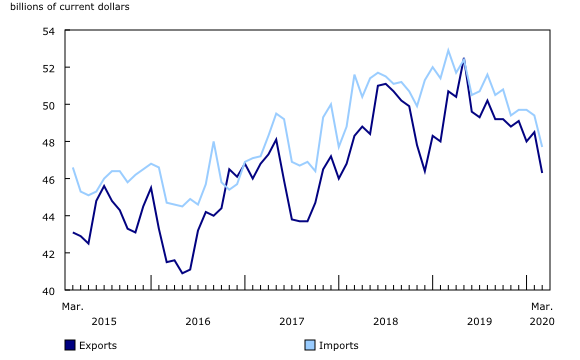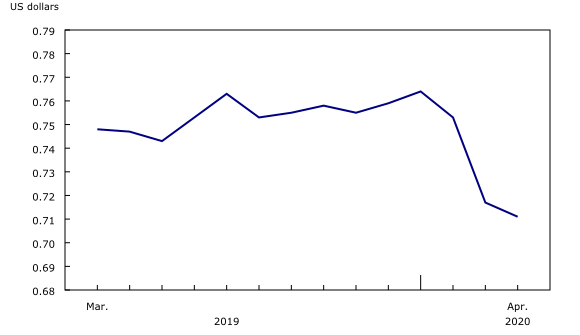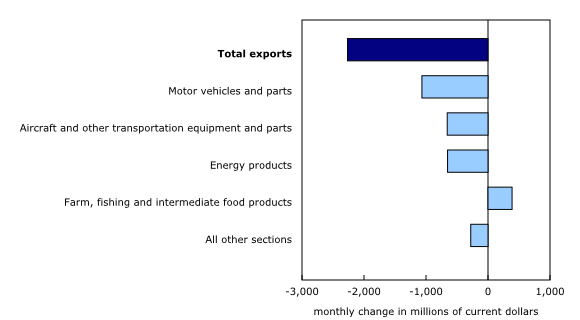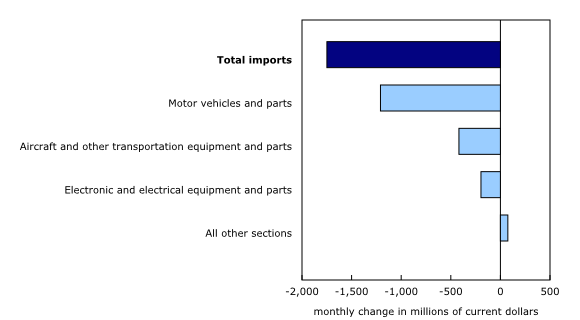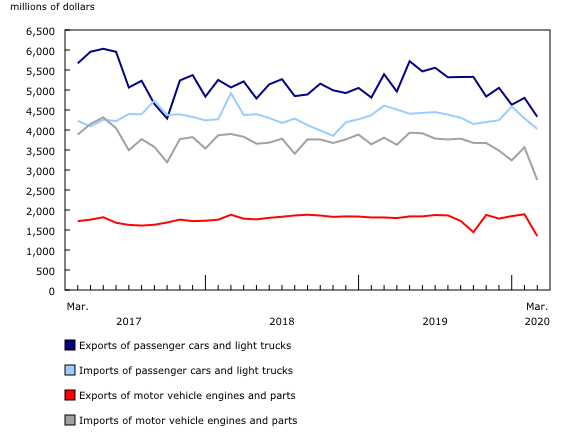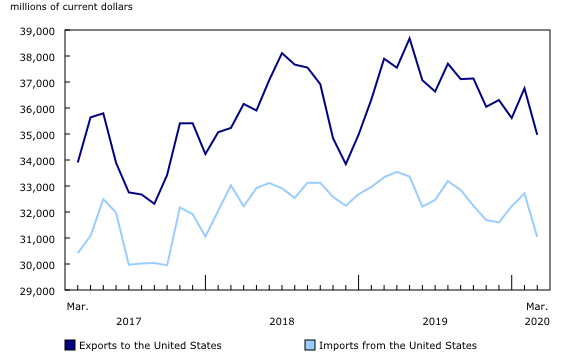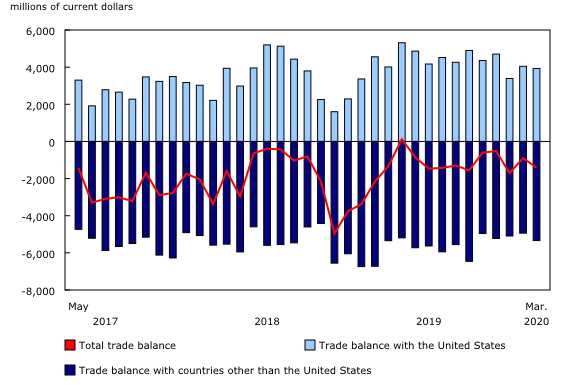Canadian international merchandise trade, March 2020
Archived Content
Information identified as archived is provided for reference, research or recordkeeping purposes. It is not subject to the Government of Canada Web Standards and has not been altered or updated since it was archived. Please "contact us" to request a format other than those available.
Released: 2020-05-05
In March, despite Canadian borders remaining open for goods, both imports and exports decreased notably, as the impact of measures to contain the spread of COVID-19 in Canada became evident. With a full month of physical distancing policies in place in April, merchandise trade values are expected to decrease more severely next month.
Canada's merchandise exports fell 4.7% to $46.3 billion in March, the lowest level since January 2018. Total imports declined 3.5% to $47.7 billion, a level not observed since October 2017. Both exports and imports were down almost 10% on a year-over-year basis. Canada's trade deficit widened from $894 million in February to $1.4 billion in March.
In real (or volumes) terms, March exports decreased 4.8% and imports were down 5.8%.
Exchange rate impacts trade values in March
For both imports and exports, a large proportion of transactions are completed in US dollars, and must be converted to Canadian dollars in the compilation of monthly trade statistics. In the case of a depreciation of the Canadian dollar against the US dollar, the result in the short run is higher trade values in Canadian dollars.
In March, the average value of the Canadian dollar decreased substantially, falling 3.6 US cents compared with the average of February. This represents the strongest average monthly decline in the value of the Canadian dollar since January 2015.
When expressed in US dollars, Canadian exports fell 9.2% in March and imports decreased 8.1%. Therefore, had the average monthly exchange rate been relatively stable in March, stronger decreases would have been likely for both exports and imports.
The monthly average exchange rate was more stable in April compared with March, but continued to decrease.
Production stoppages in the auto manufacturing industry lead to strong declines in both exports and imports of motor vehicles and parts
In March, automakers and several auto engine and parts suppliers in North America began to cease production (or shifted production to medical equipment) as physical distancing measures were introduced. This had a significant impact on both exports and imports of these products. Exports of passenger cars and light trucks decreased 9.8% in March, while imports fell 6.2%. As for engines and parts, exports dropped 28.9% and imports decreased 23.0%.
These production stoppages continued throughout the month of April and into May. Low levels of exports and imports for these products should therefore be expected until production resumes.
Trade in aircraft and other transportation equipment and parts down in March after a strong February
Following strong increases in February, exports and imports of aircraft and other transportation equipment and parts were down in March. Aircraft exports fell $469 million, after increasing $364 million in February. Meanwhile, exports of boats and other transportation equipment fell 63.3% to $97.7 million, the lowest level since January 2018.
On the import side, aircraft engines and parts fell $175 million in March. Imports of aircraft also decreased (-$169 million), following a $565 million increase in February.
There were notable work stoppages in industries that produce aircraft and other transportation equipment that began towards the end of March and continued into April. These stoppages will likely affect imports and exports of goods that are related to that industry in the upcoming months.
Energy product exports down on lower demand
The importance of energy products to Canadian exports is one of the main reasons for the larger decrease observed in total exports compared with imports during the month. Energy products comprised about 19.2% of Canadian exports in 2019, while imports of energy products accounted for 6.1% of total imports in 2019.
Exports of energy products decreased 7.4% in March, a third consecutive monthly decline. Exports of crude oil were down 7.9% on both lower prices as well as lower volumes, mainly reflecting weaker global demand for crude oil in March. Since fluctuations in oil prices are normally observed with a certain delay in exports statistics, the recent collapse in market prices could affect crude oil export values more severely in future months. In March, non-energy exports were down 4.1%.
Exports of refined petroleum products (-9.8%) were down for a fifth consecutive month. Lower prices were behind this decrease, while volumes rose in March.
Imports of energy products were down 5.2%, mainly on lower imports of crude oil (-12.8%). Both crude oil prices and volumes declined in March.
Rebound in exports of farm, fishing and intermediate food products amid end of rail blockades
Moderating the overall decrease in exports in March were higher exports of farm, fishing and intermediate food products (+12.1%). This increase was mainly the result of the clearing of a grain backlog after rail blockades were lifted at the beginning of March. Increases were observed in almost all sub-categories, led by other crop products, wheat and canola.
Sharp decline in trade with the United States
With the auto industry on pause at the end of March, and lower demand for crude oil, the United States was the main contributor to the decreases in total exports and imports this month. Exports to the United States were down 4.9%, while imports fell 5.1%. These declines were likely attenuated by a weaker Canadian currency in March. The trade surplus with the United States narrowed slightly from $4.0 billion in February to $3.9 billion in March.
Exports to countries other than the United States also decreased in March (-4.1%), mainly on lower exports to the United Kingdom (gold) and Saudi Arabia (other transportation equipment). Imports from non-US countries were down 0.5%, due to lower imports from Mexico (-14.4%) and Germany (-10.2%), both in part on decreased imports of motor vehicles and parts. The trade deficit with countries other than the United States widened from $4.9 billion in February to $5.3 billion in March.
Following two months of sharp decreases, imports from China (-1.1%) fell slightly in March. However, on a year-over-year basis, imports from that country plunged 32.9%. Exports to China decreased 2.3% in March, but were down 16.1% compared with March 2019.
First quarter results
In the first quarter of 2020, exports decreased 3.0%, a third consecutive quarterly decline. Exports of energy products (-6.8%) and motor vehicles and parts (-6.6%) contributed the most to the decrease.
Following a 2.0% decrease in the last quarter of 2019, imports decreased 2.0% once again in the first quarter of 2020. This was the fourth consecutive quarterly import decrease. Imports of electronic and electrical equipment and parts (-7.7%), which were impacted by decreased trade with China, posted the largest quarterly decline. This was followed by a decrease in imports of motor vehicles and parts (-3.8%).
On a constant dollar basis, exports decreased 1.7% in the first quarter of 2020. This followed a 1.2% decline in the last quarter of 2019. Real imports were down 2.5% in the first quarter, after decreasing 1.1% in the previous quarter.
Revisions to February merchandise exports and imports
Imports in February, originally reported as $49.3 billion in the previous release, were revised to $49.4 billion in the current month's release. Exports in February, originally reported as $48.3 billion in the previous release, were revised to $48.5 billion.
Trade in medical and protective goods
The article "Trade in medical and protective goods" was released today. This article examines recent trends in exports and imports of products required for the prevention, testing and treatment of COVID-19, providing a basis for understanding the potential impact of the pandemic on Canada's international merchandise trade. To this end, Statistics Canada has produced a special data compilation to examine trade in particular categories of products, specifically disinfectants and sterilization products, personal protective equipment, medical equipment and products, and diagnostic products.
Monthly trade in services
Monthly exports of services decreased 7.2% to $10.4 billion in March, while imports of services fell 11.5% to settle at $11.4 billion.
Combining international trade in goods and services, exports declined 5.1% to $56.6 billion in March, while imports were down 5.2% to $59.0 billion. As a result, Canada's trade deficit with the world for goods and services combined totalled $2.4 billion in March.
Note to readers
Merchandise trade is one component of Canada's international balance of payments (BOP), which also includes trade in services, investment income, current transfers, and capital and financial flows.
International trade data by commodity are available on both a BOP and a customs basis. International trade data by country are available on a customs basis for all countries and on a BOP basis for Canada's 27 principal trading partners (PTPs). The list of PTPs is based on their annual share of total merchandise trade—imports and exports—with Canada in 2012. BOP data are derived from customs data by making adjustments for factors such as valuation, coverage, timing and residency. These adjustments are made to conform to the concepts and definitions of the Canadian System of National Accounts.
For a conceptual analysis of BOP versus customs-based data, see "Balance of Payments trade in goods at Statistics Canada: Expanding geographic detail to 27 principal trading partners."
For more information on these and other macroeconomic concepts, see the Methodological Guide: Canadian System of Macroeconomic Accounts (13-607-X) and the User Guide: Canadian System of Macroeconomic Accounts (13-606-G).
Data in this release are on a BOP basis and are seasonally adjusted. Unless otherwise stated, values are expressed in nominal terms, or current dollars. References to prices are based on aggregate Paasche (current-weighted) price indexes (2012=100). Volumes, or constant dollars, are calculated using the Laspeyres formula (2012=100).
For information on seasonal adjustment, see Seasonally adjusted data – Frequently asked questions.
Revisions
In general, merchandise trade data are revised on an ongoing basis for each month of the current year. Current-year revisions are reflected in both the customs and BOP-based data.
The previous year's customs-based data are revised with the release of the January and February reference months, and thereafter on a quarterly basis. The previous two years of customs-based data are revised annually, and revisions are released in February with the December reference month.
The previous year's BOP-based data are revised with the release of data for the January, February, March and April reference months. To remain consistent with the Canadian System of Macroeconomic Accounts, revisions to BOP-based data for previous years are released annually in December with the October reference month.
Factors influencing revisions include the late receipt of import and export documentation, incorrect information on customs forms, replacement of estimates produced for the energy section with actual figures, changes in classification of merchandise based on more current information, and changes to seasonal adjustment factors.
For information on data revisions for crude oil and natural gas, see "Revisions to trade data for crude oil and natural gas."
Revised data are available in the appropriate tables.
Real-time data table
Real-time table 12-10-0120-01 will be updated on May 19.
Next release
Data on Canadian international merchandise trade for April will be released on June 4.
Products
Because of the current situation, the product "International Trade Explorer" (71-607-X) will not be updated with revised data published in the current month.
Customs-based data are now available in the Canadian International Merchandise Trade Database (65F0013X).
The updated Canada and the World Statistics Hub (13-609-X) is now available online. This product illustrates the nature and extent of Canada's economic and financial relationship with the world using interactive graphs and tables. This product provides easy access to information on trade, investment, employment and travel between Canada and a number of countries, including the United States, the United Kingdom, Mexico, China, Japan, Belgium, Italy, the Netherlands, and Spain.
Contact information
For more information, contact us (toll-free 1-800-263-1136; 514-283-8300; STATCAN.infostats-infostats.STATCAN@canada.ca).
To enquire about the concepts, methods or data quality of this release, contact Benoît Carrière (613-415-5305; benoit.carriere@canada.ca), International Accounts and Trade Division.
- Date modified:



